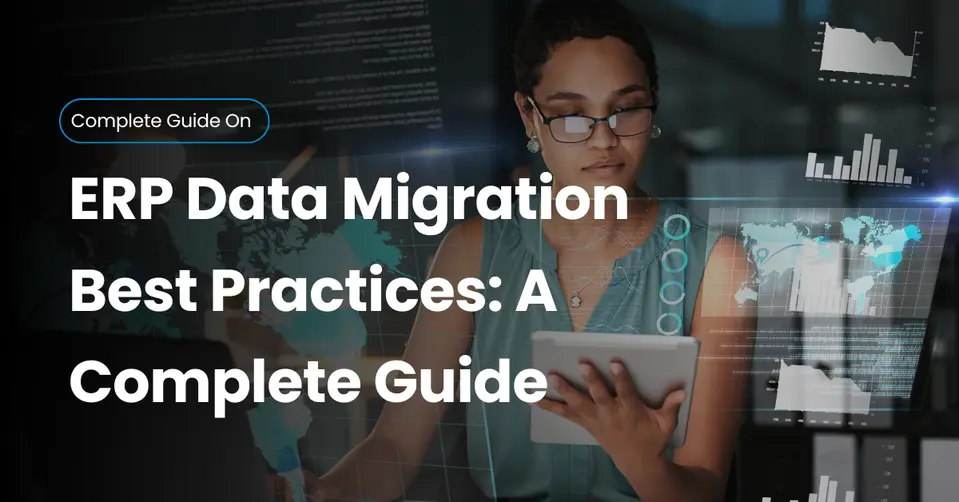If you’ve ever moved into a new house, you know how tricky it is to pack, transport, and unpack without losing or breaking anything. ERP data migration is a lot like that — but instead of furniture, you’re moving valuable business data. One wrong move, and it can cost time, money, and customer trust.
In this guide, you’ll discover ERP Data Migration Best Practices that make the transition smooth, whether you’re upgrading from a legacy system, moving to the cloud, or consolidating multiple platforms. We’ll walk through practical steps, common pitfalls, and expert strategies so you can start your ERP migration project with confidence.
What is ERP Data Migration in ERPNext?
ERP data migration is the process of transferring your company’s information — from financial records to inventory lists — into a new ERP system like ERPNext. It’s not just about moving files. It’s about ensuring accuracy, security, and compatibility so your business doesn’t skip a beat.
When migrating from a legacy ERP system, businesses often move master data, transactional history, and even custom modules. The process can differ between ERP cloud migration and ERP on-premise migration, so your ERP migration strategy should account for the specific infrastructure and compliance requirements of each.
When Should You Consider ERP Data Migration?
Sometimes the signs are obvious. Your ERP is slow, outdated, or missing features your team desperately needs. Other times, it’s about future-proofing — making sure your systems can handle growth, new regulations, or changing market demands. Either way, timing matters.
Moving to a modern platform like ERPNext is ideal when your business is expanding, you’re replacing a legacy ERP, or you need better integration with cloud tools. Done right, an ERP migration plan not only improves workflows but also reduces costs and boosts long-term efficiency.
1. Upgrading to ERPNext from Legacy ERP
Older ERP systems can be rigid and hard to customize. Upgrading brings automation, better reporting, and easier scalability — all crucial for staying competitive.
2. Migrating from Other Platforms to ERPNext
Switching from SAP, Odoo, or Microsoft Dynamics? A clear ERP migration roadmap helps avoid compatibility issues and data transfer errors.
3. Moving ERPNext from On-Premise to Cloud
Cloud migration reduces maintenance costs, improves accessibility, and supports remote teams without compromising security.
4. Consolidating Multiple Systems into ERPNext
Merging data silos into one system streamlines reporting and eliminates duplicate records.
5. Ensuring Compliance and Process Standardization
ERPNext migration supports data governance and compliance with USA regulations like GDPR and industry-specific standards.
Key Steps in ERP Data Migration
A successful ERP migration process is rarely a single event. It’s a series of ERP migration phases that build on each other, from planning to post-launch optimization. Skipping a step is like trying to bake bread without letting it rise — it simply won’t turn out right.
Here’s the basic ERP migration lifecycle most companies follow:
Assess your data, map it to the new system, extract it safely, clean it up, validate its accuracy, load it into the new ERP, and then test everything. This approach minimizes ERP migration risks and keeps your project on schedule.
1. Data Assessment
Review all datasets, decide what’s essential, and archive outdated records to reduce migration time.
2. Data Mapping
Ensure each old field matches a new one to prevent data mismatch issues.
3. Data Extraction
Use safe transfer methods to protect sensitive business information.
4. Data Transformation and Cleansing
Remove duplicates, fix formatting, and update outdated info before the move.
5. Data Validation
Run checks to confirm ERP data quality before loading.
6. Data Loading
Schedule uploads outside business hours to reduce downtime.
7. Testing and Go-Live
Simulate real workflows and confirm reports match expectations before launch.
Challenges in ERP Data Migration
Even with the best ERP Data Migration Best Practices, things can get messy. Data might not align perfectly, team members can miss steps, and unexpected system errors can slow everything down. The good news? Knowing the ERP migration challenges up front makes them easier to prevent.
The biggest risks often involve data quality, security, downtime, and a lack of expertise in ERP migration steps. These can derail your timeline and push up costs. But with the right planning, strong testing, and a reliable ERP migration partner, you can avoid most of these pitfalls.
1. Data Quality Issues:
Bad data in means bad data out. Cleaning records before the move prevents ERP migration mistakes later.
2. Complex Data Structures:
Merging data from multiple systems can cause mapping conflicts without a detailed plan.
3. Data Security Concerns:
Encryption, access controls, and compliance checks protect sensitive ERP data.
4. Downtime and Disruption:
Scheduling around peak business hours keeps ERP migration downtime to a minimum.
5. Lack of ERPNext Expertise:
Experienced teams reduce errors and ERP migration costs.
6. Inadequate Testing:
Skipping tests risks ERP migration failures that are expensive to fix.
Best Practices for ERP Data Migration (ERPNext-Centric)
Think of these as your ERP migration checklist — the habits and steps that separate smooth, on-time projects from stressful, over-budget ones. Each one helps lower ERP migration risks and improve the odds of success.
The key? Start early, stay organized, and keep communication open. These ERP migration best practices work for small moves and massive multi-system upgrades alike. Let’s break them down.
1. Start Planning Early
The earlier you define your ERP migration strategy, the easier it is to avoid surprises.
2. Implement Strong Data Governance
Clear rules keep ERP master data management (MDM) consistent post-migration.
3. Create a Detailed Data Mapping Strategy
Prevent errors by aligning every field with ERPNext’s database structure.
4. Use Phased Migration for Large Projects
Moving in stages avoids ERP migration downtime and stress.
5. Test Thoroughly at Every Stage
Spot issues before they affect ERP workflows.
6. Maintain Backups and Contingency Plans
Always have a fallback if the unexpected happens.
7. Train Your Team in ERPNext Early
ERP training ensures employees are ready from day one.
Infintrix ERP Migration Plan
A solid ERP migration plan is like a GPS for your project — it keeps everyone on track and reduces wrong turns. At Infintrix, we use a step-by-step method designed to make ERP data migration smooth, secure, and efficient.
Our approach covers everything from data analysis to post-migration fine-tuning. Each phase has clear deliverables, so you always know what’s happening and when. Here’s how we do it.
Step 1. Discovery & Planning:
We start by understanding your business goals, processes, and compliance needs.
Step 2. Data Analysis & Preparation:
Old, duplicate, or irrelevant records are cleaned to ensure ERP data quality.
Step 3. Migration Execution:
We use encryption and tested tools for safe ERP data transfer.
Step 4. Testing & Validation:
Every dataset is checked against the original for data accuracy.
Step 5. Training & Go-Live Support:
Hands-on training helps your team hit the ground running.
Step 6. Post-Migration Optimization:
We fine-tune workflows to boost ERP productivity and ROI.
ERP Data Migration Checklist
Think of this as your quick-hit ERP migration roadmap. Check off each item to stay on track:
- Conduct a pre-migration ERPNext audit
- Define migration goals and KPIs
- Select the right ERP migration tools
- Ensure data regulation compliance
- Schedule migration for minimal downtime
- Prepare rollback and recovery plans
Popular ERP Migration Tools (with ERPNext integration capability)
Choosing the right tool can make or break your ERP migration project. Here are some top options:
1. Frappe Data Import Tool (Native ERPNext)
Perfect for smaller migrations with built-in ERP data import capabilities.
2. Boomi
Cloud-based integration with advanced automation for large enterprises.
3. Celigo
Ideal for hybrid ERP migration and API-driven integrations.
4. Informatica PowerCenter
Enterprise-grade tool for complex ERP database migration projects.
5. SAP Data Services
Excellent for large-scale data transformation needs.
How to Choose the Right ERP Migration Vendor
Your ERP migration vendor is more than just a service provider — they’re your partner in avoiding ERP migration pitfalls. Look for:
- ERPNext specialization and certifications
- Experience in your specific industry
- Transparent timelines and budgets
- A solid post-migration support plan
Why Infintrix is the Right Choice for Your ERPNext Migration
At Infintrix, we don’t just “do” migrations — we live and breathe ERPNext. Our dedicated team has handled everything from legacy ERP replacement to complex cloud ERP migration.
We follow a proven process, minimize downtime, and offer end-to-end ERP migration support — from planning to optimization — so you can focus on running your business without disruption.
Final Thoughts
ERP Data Migration Best Practices aren’t just theory — they’re the difference between a smooth transition and a costly mess. With the right plan, team, and tools, your move to ERPNext can be faster, safer, and far less stressful.
Think of this as a long-term investment. Partnering with experts like Infintrix means you’re not just moving data — you’re setting your business up for the next stage of growth.
FAQs
What is ERPNext data migration?
It’s the process of moving your business data, configurations, and modules into ERPNext while ensuring accuracy and security.
How long does an ERPNext migration take?
Timelines vary based on data size, complexity, and the ERP migration strategy used — typically weeks to a few months.
What are the risks of ERP data migration?
Common risks include data loss, downtime, and migration errors, which can be minimized with proper testing.
Can you migrate from any ERP to ERPNext?
Yes — with the right data mapping and migration tools, almost any ERP can be moved to ERPNext.
How much does ERPNext migration cost with Infintrix?
Costs depend on scope, complexity, and custom requirements. We provide transparent quotes after an initial audit.

